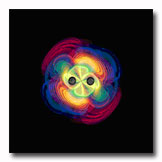 |

|
 |
National Science Foundation Releases "Women, Minorities, and Persons with Disabilities in Science and Engineering 2004"—New Online Report Provides Easy Access, Timely Updates
According to a new report, Asian/Pacific Islanders living in the United States earn more science or engineering (S&E;) bachelor's degrees than whites earn, relative to their college-age (20-24 year old) peers. Meanwhile, data on blacks, Hispanics, and American Indian/Alaska Natives show steady, although small, increases in the number of S&E; bachelor's degrees earned during the same period. The new, online report, Women, Minorities, and Persons with Disabilities in Science and Engineering 2004, will allow users to more easily search for data and presentation viewgraphs by education level, employment, and population group. In addition, data for different sections of the web-based report will be updated as new data become available
More...
(posted June 21, 2004)
|
 |
|
 |
The familiar bell pepper, Capsicum annuum, comes in an array of hues.
Credit: Photo courtesy of Chile Pepper Institute
|
Pepper
Prodigies Pursue Plants Like Those Picked by Parents—Migrant
farmworkers' children, grandchildren research at NMSU's Chile Pepper
Institute
At the Chile Pepper Institute at New Mexico State University, research can be pretty hot and kind of cool at the same time. There will also be an ancestral sweetness to it for the 10 college freshmen and sophomores in the institute's eight-week summer program, as they are children and grandchildren of migrant and seasonal farmworkers. The program, in its second summer and running through July 30, is called Assured, for Agriculture Summer Science Research and Development. It provides each student a $3,000 stipend to work in the research labs and design their project, along with room and board at the Las Cruces campus.
More...
(posted June 21, 2004)

|
 |
|
Digital Preservation Program Launches Research Grants Initiative—
Library of Congress partners with National Science Foundation to fund advanced research into preservation of digital materials
The National Digital Information Infrastructure and Preservation Program of the Library of Congress (NDIIPP) is partnering with the National Science Foundation (NSF) to establish the first research grants program to specifically address digital preservation. NSF will administer the program, which will fund cutting-edge research to support the long-term management of digital information. This effort is part of the Library's collaborative program to implement a national digital preservation strategy. "One of the most critical issues we face in the preservation of digital materials is a need for better technology and methods to manage these artifacts over long periods of time," said Associate Librarian for Strategic Initiatives Laura E. Campbell, who is directing the initiative for the Library. "We are very pleased to be working with the National Science Foundation to encourage important research breakthroughs. This will help the Library of Congress, as well as our network of partners who are working with us, to preserve America's digital heritage for future generations."
More...
(posted June 21, 2004)

|
 |
|
 |
This numerical simulation is part of a series depicting orbiting black holes and represents the first time that three-quarters of a full orbit has been computed.
Credit: Scientific contact by Ed Seidel (eseidel@aci.mpg.de); simulations by Max Planck Institute for Gravitational Physics (Albert-Einstein-AEI); visualization by Werner Benger – Zuse Institute, Berlin (ZIB) and AEI. The computations were performed on NCSA's Ita
|
Orbiting Black Holes (from the New Additions Section in the NSF Image Library)
This numerical simulation is part of a series depicting orbiting black holes and represents the first time that three-quarters of a full orbit has been computed. The simulations show the merger of two black holes and the ripples in spacetime-known as gravitational waves-that are born of the merger. These simulations were created on the National Center for Supercomputing Applications (NCSA) Itanium Linux Cluster by researchers from the Max Planck Institute for Gravitational Physics (Albert Einstein Institute) in Potsdam, Germany, and visualized by Werner Benger of the Albert Einstein Institute and the Konrad-Zuse-Zentrum in Berlin. The simulation was completed in the Spring of 2002.
More... (posted
June 21, 2004)

|
 |
| |

|

